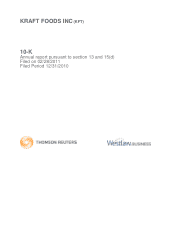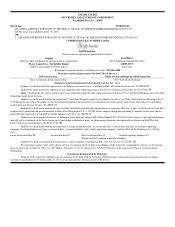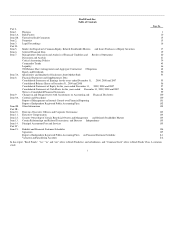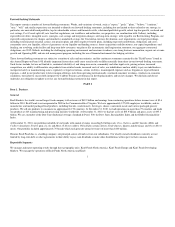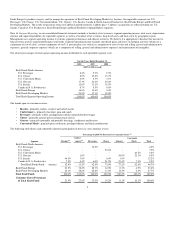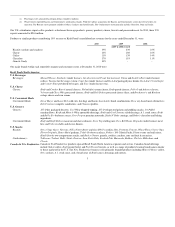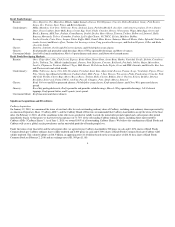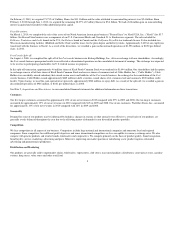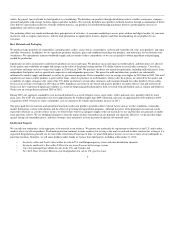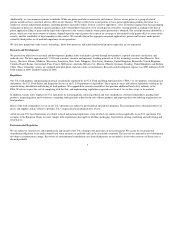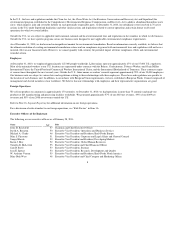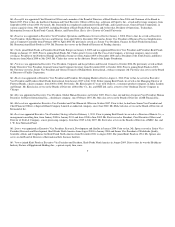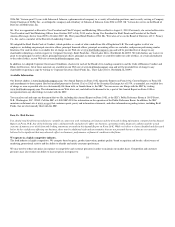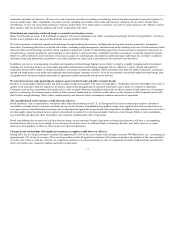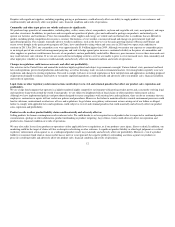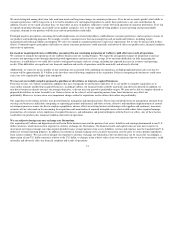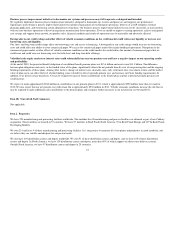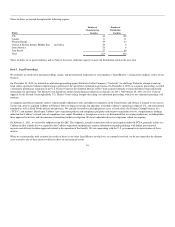Kraft 2010 Annual Report Download - page 9
Download and view the complete annual report
Please find page 9 of the 2010 Kraft annual report below. You can navigate through the pages in the report by either clicking on the pages listed below, or by using the keyword search tool below to find specific information within the annual report.
outlets. In general, the retail trade for food products is consolidating. We distribute our products through distribution centers, satellite warehouses, company-
operated and public cold-storage facilities, depots and other facilities. We currently distribute most products in North America through a combination of direct
store delivery and warehouse delivery. Outside of North America, our products are distributed through warehouse delivery and through the services of
independent sales offices and agents.
Our marketing efforts are conducted through three principal sets of activities: (i) consumer marketing in on-air, print, outdoor and digital media; (ii) consumer
incentives such as coupons and contests; and (iii) trade promotions to support price features, displays and other merchandising of our products by our
customers.
Raw Materials and Packaging
We purchase large quantities of commodities, including dairy, coffee, cocoa, wheat, corn products, soybean and vegetable oils, nuts, meat products, and sugar
and other sweeteners. In addition, we use significant quantities of plastic, glass and cardboard to package our products, and natural gas for our factories and
warehouses. We continuously monitor worldwide supply and cost trends of these commodities so we can act quickly to obtain ingredients and packaging
needed for production.
Significant cost items in chocolate confectionery products are cocoa and sugar. We purchase cocoa and sugar on world markets, and their prices are affected
by the quality and availability of supply and changes in the value of the pound sterling and the U.S. dollar relative to certain other currencies. Cocoa bean,
cocoa butter and sugar costs on average were higher in 2010 than in 2009. We purchase our dairy raw material requirements, including milk and cheese, from
independent third parties such as agricultural cooperatives and independent processors. The prices for milk and other dairy products are substantially
influenced by market supply and demand, as well as by government programs. Dairy commodity costs on average were higher in 2010 than in 2009. The most
significant cost item in coffee products is green coffee beans, which we purchase on world markets. Green coffee bean prices are affected by the quality and
availability of supply, changes in the value of the U.S. dollar in relation to certain other currencies and consumer demand for coffee products. Green coffee
bean costs on average were higher in 2010 than in 2009. Significant cost items in our biscuit and grocery products are grains (wheat, corn and soybean oil).
Grain costs have experienced significant volatility as a result of burgeoning global demand for food, livestock feed and biofuels such as ethanol and biodiesel.
Grain costs on average decreased from 2009 to 2010.
During 2010, our aggregate commodity costs increased primarily as a result of higher cocoa, sugar, dairy, coffee and meat costs, partially offset by lower
grain costs. For 2010, our commodity costs were approximately $1.0 billion higher than 2009, following a decrease of approximately $150 million in 2009
compared to 2008. Overall, we expect commodity costs to continue to be volatile and to further increase in 2011.
The prices paid for raw materials and agricultural materials used in our products generally reflect external factors such as weather conditions, commodity
market fluctuations, currency fluctuations and the effects of governmental agricultural programs. Although the prices of the principal raw materials can be
expected to fluctuate as a result of these factors, we believe there will be an adequate supply of the raw materials we use and that they are generally available
from numerous sources. We use hedging techniques to limit the impact of price fluctuations in our principal raw materials. However, we do not fully hedge
against changes in commodity prices, and these strategies may not protect us from increases in specific raw material costs.
Intellectual Property
We consider our trademarks, in the aggregate, to be material to our business. We protect our trademarks by registration or otherwise in the U.S. and in other
markets where we sell our products. Trademark protection continues in some countries for as long as the mark is used and in other countries for as long as it is
registered. Registrations generally are for renewable, fixed terms. From time to time, we grant third parties licenses to use one or more of our trademarks in
particular locations. Similarly, we sell some products under brands we license from third parties, including at December 31, 2010:
• Starbucks coffee and Seattle's Best coffee for sale in U.S. and European grocery stores and other distribution channels;
• Starbucks and Seattle's Best coffee T-Discs for use in our Tassimo hot beverage system;
• Capri Sun packaged juice drinks for sale in the U.S. and Canada; and
• Taco Bell Home Originals Mexican style food products for sale in U.S. grocery stores.
6

